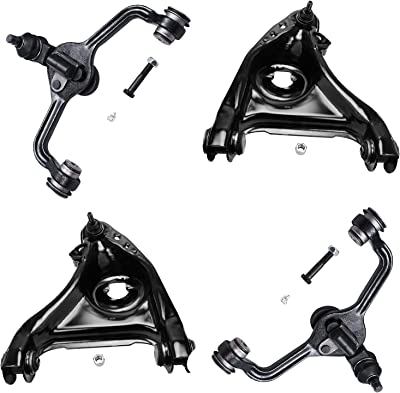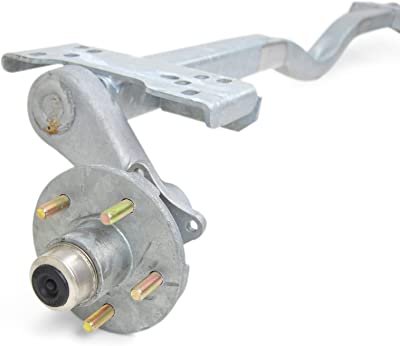Every automobile’s suspension design differs, from the leaf spring to the multi-link, and in others, we have seen many variations of suspensions. Double Wishbone and Torsion Beam play the famous fight among them. But who is victorious in Double Wishbone vs. Torsion Beam?
How do they differ from each other? A double wishbone suspension features two control arms, whilst a torsion beam suspension is an H-shaped suspension. In general, double wishbones suspension setups are found in performance cars.
However, torsion beam suspension is most common in mid-level and front-wheel drive cars. To give a more clarified idea, we have discussed several things below. Let’s see.
What is A Double Wishbone Suspension?

To illustrate a dual wishbone suspension, let’s take a brief look at the independent suspension system. Any vehicle suspension set up to allow each wheel to move independently following an external influence (i.e. upon a bump) is independent suspension.
If a vehicle’s independent suspension is working properly, the wheels move upward and forward on both sides of the vehicle independently when traveling over terrain that isn’t flat.
In the car with double wishbone suspensions, there are two wishbone arms, one on the rear of the vehicle and the other mounted directly on it. Thus, one wishbone arm turns the wheel, and the other handles the vertical direction.
Wishbones have two flexible joints in the knuckles and one pivot point on the rack to act as an independent (non-compressible) valve. A spring shock absorber is attached to each wishbone as a means to run the vertical axis.
With its durable design, the double wishbone suspension has become a well-known car component because of its effectiveness in striking a proper balance between driver comfort and vehicle performance.
What is Torsion Beam Suspension?

The torsion beam suspension setup is also known as the twist beam suspension. This type of suspension makes a natural-feeling connection to the rear wheels, even if it’s excessively mechanical. Popularly found at the rear, the torsion beam suspension relies on the trailing arms along with a cross-rod that twists as the wheels move.
A torsion beam is a suspension system that has its setup based on a trailing arm suspension and is used chiefly on small to large front-wheel drive vehicles. It uses a spring coil close to the shock absorber or over it. However, some vehicles are now able to circumvent the anti-roll bar due to the torsion beam design’s ability to flex each side differently.
Unlike performance suspension packages, the torsion beam suspension has demonstrated success with vehicles that are typically considered “limited performance” vehicles. For example, Volkswagen’s Golf GTI into big rigs such as GMC’s Sierra 1500.
Popular among automobile designers so as not to take up much space in the backseats of the passenger compartments, the torsion-type load-bearing system has a relatively low cost of production and high durability and reliability.
Double Wishbone vs. Torsion Beam – Working Mechanism
The distinct working mechanism holds the concrete difference between double and torsion, even though both are considered independent suspensions. So, let’s see how they work.
Double Wishbone
A double wishbone suspension system gets its double wishbone nickname because of the design that uses two control arms or wishbones that hold the wheel knuckle along with the spindle. While some setup configurations may vary, there is a standard recipe for a wishbone suspension.
The wheel knuckle and spindle are usually supported by a ball and socket joint assembly on newer systems. The wide-angle control arms are connected to the frame with a pivot point and then attached to the steering column using a universal joint.
On the drive shafts, the differential and hub flanges are connected to the axle half-shafts are aligned with CV or U-joints, allowing the wheels to move up and down. It is worth noting that the side-to-side operation of a front-wheel drive is also helped. The shock absorber, spring, and axle halves are interconnected and allow vertical movement.
Torsion Beam
The torsion beam is a suitably fascinating technical advance. When one wheel experiences a deviation from the freeway path that’s not overly large, only that side’s suspension actuates. We can simplify that the suspension acts separately concerning that matter. If the deviation is greater, the wheel on the opposite side also acts interdependently.
Since the axle is mounted in front of the wheels and can transmit a wide range of torque through torsion bars, it provides a special task for them. For this reason, the torsion bars function as a torque equalizer. Still, because this can sometimes be substituted for another anti-roll bar, the torque equalizer can also be utilized as a secondary anti-roll bar.
Double Wishbone vs. Torsion Beam – Comfort and Convenience
As an independent suspension setup, a double wishbone suspension system is composed of a wishbone link, which ensures that if any one wheel hits an obstacle on the trail, the other wheel will not be impacted since they are not connected, offering superior comfort.
Some point out that a torsion beam provides better off-road stability, the latter of which is similar to employing a strut bar or sway bar to the “independent” suspension. You should not just depend on the opinion of other car buyers. So, you ought to feel the car for yourself.
Those who favor double wishbone design should not say the prior Honda Concerto is more comfortable and better to handle than the Forte and many other modern vehicles. It is not just the type of car; the design and tuning to suit driving on the local roads play a big part. Likewise, structure rigidity also plays an important role.
Double Wishbone vs. Torsion Beam – Design and Construction
The biggest difference between a double wishbone suspension and one that allows torsion beam suspension is that on a torsion beam, both wheels are independent of each other, and one wheel has a relatively large influence on the other.
Still, on a double wishbone, you simply have an independently operated suspension system in which the two wheels are roughly independent of the other except for the steering of the front wheels.
In a wishbone suspension setup, the wishbones and control arms are crafted from various materials, including cast iron, aluminum, and pressed steel. On the other hand, round structural steel may be used to make various kinds of Torsion impact beam suspensions, including those with grade levels ranging from SAE 8660 to SAE 9262.
Of these grades, SAE 8660 and SAE 9262 yield an as-quenched hardness at the center of the bar of about 55 Rockwell C maximum. And in terms of durability, torsion beam suspensions will stay ahead due to their more rugged construction.
Double Wishbone vs. Torsion Beam – Unsprung Weight
The unsprung weight is a distinctive aspect of the suspension parameters that significantly influences its performance. The unsprung weight tends to improve the responsiveness of the suspension. The lower the unsprung weight, the harder it is for the tire to move around the blacktop by its suspension.
Less stress on vehicle structures can mean more rigid design choices, such as double wishbones. Within this contrast, there is no match; conventional wisdom supports double wishbones because they can better compensate for weight loading.
Double Wishbone vs. Torsion Beam – Repair or Maintenance Cost
Double wishbone suspension setups typically cost more than torsion beam loops simply because more parts comprise a double wishbone suspension setup, and these systems are more complicated to work on than their torsion beam counterparts.
A standard torsion beam suspension setup has just a single bushing that supports the trailing arm to the chassis, making installing torsion beam setups simpler. At the same time, it diminishes the maintenance cost as well.
Pros and Cons of Double Wishbone Suspension
Now, let’s have a quick look at some of the notable pros and cons of a double wishbone suspension system.
Pros:
- More design choices
- Greater opportunity for fine-tuning
- Increased negative camber gain
- Excellent load capacity
- Incredible handling
- Better flexibility
Cons:
- Complex design
- Difficulty in repair and maintenance
- Expensive
Pros and Cons of Torsion Beam Suspension
Now, we have the Torsion Beam suspension system here to explore some of its positive and negative facts.
Pros:
- Fairly lightweight
- Doesn’t require a separate anti-roll bar
- Reduced clutter underneath
- Simple design
- Rigid construction
- Low cost
Cons:
- Lack of adjustability
- Not superior camber characteristics
- Altering the factory specifications may impact badly on the axle and joints
Double Wishbone vs. Torsion Beam – Final
So, from the battle of Double Wishbone vs. Torsion Beam, which one will be your preferred option? Still confused? Let’s give our final verdict. Like any other component, even the car, the choice depends on what you want, your driving habits, and of course, your budget.
As you can see, a double wishbone suspension is more expensive to repair and maintain; also, its design has more complexity. If all of these bother you, choosing the torsion beam suspension would be a wise decision.
However, if you’re a performance seeker, and driving, comfort, and control are your prime considerations, simply choose the double wishbone suspension. But make sure to check the compatibility first.